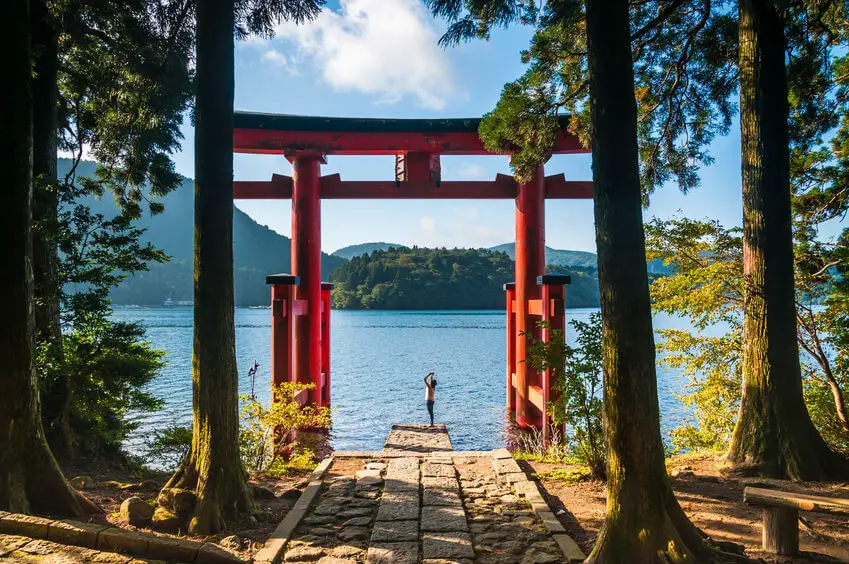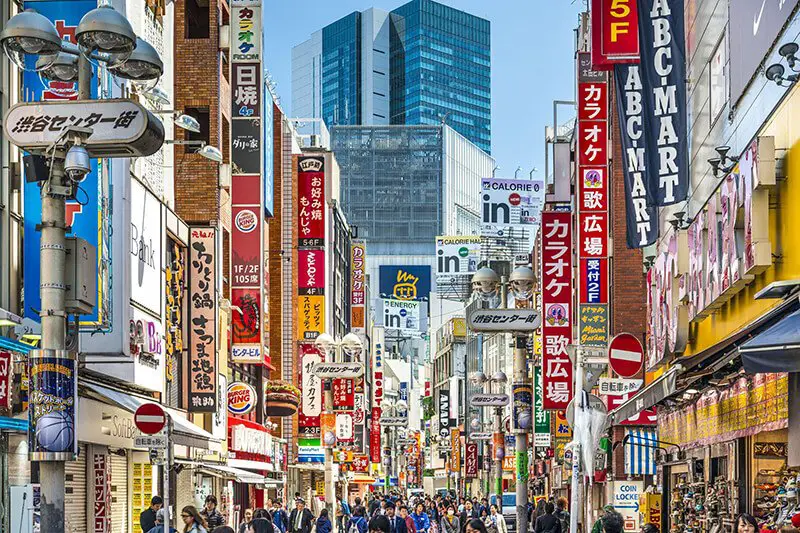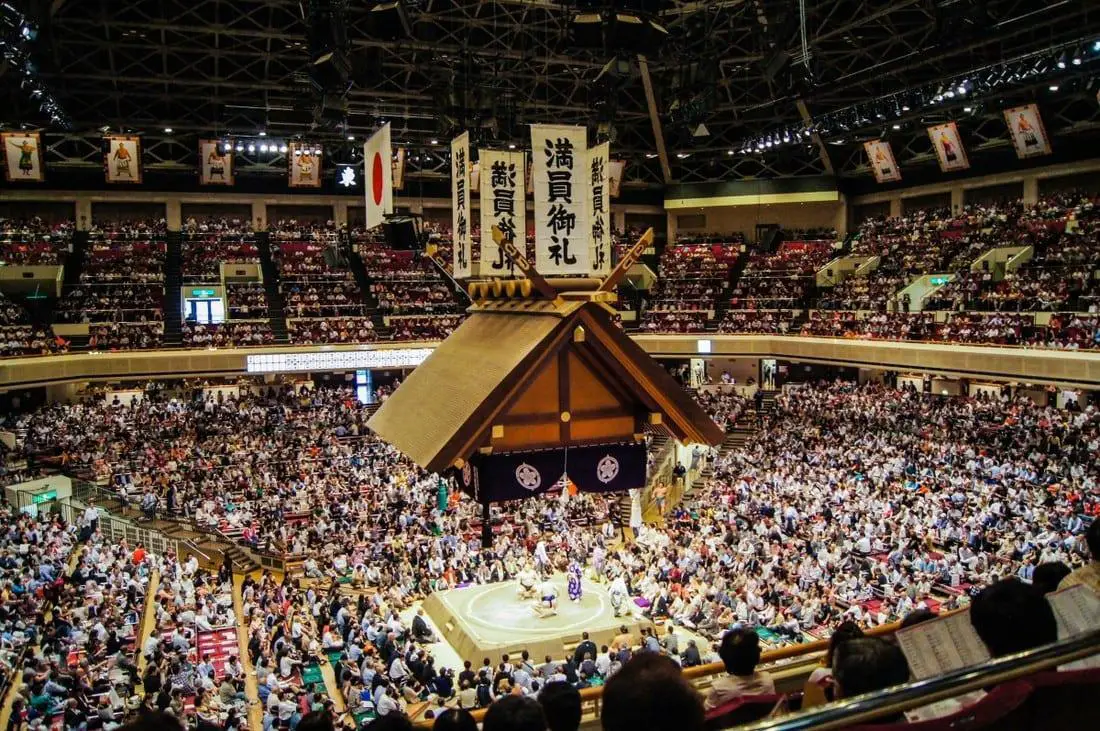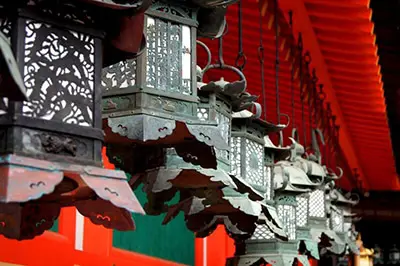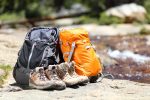If you have a couple of spare days left in your itinerary and aren’t quite ready to leave Tokyo just yet, then we would suggest that you take a daytrip to Hakone.
We love a day trip, it’s like a miniature holiday during a holiday. And there so many areas near Tokyo that are worth an excursion. You could get a close-up view of Mount Fuji from the Five Lakes area. You could get to know one of Japan’s most loved TV characters in Shibamata. Or you could take a trip back in time to Kawagoe. But as a first-time Tokyo visitor, we highly recommend you spend your day outside of Tokyo immersed in nature in iconic Hakone.
Hakone (箱根) located 100 kilometres North of Tokyo, is part of the Fuji-Hakone-Izu National Park. It is particularly famous for its hot springs, natural beauty, staggering amount of onsen day spas and the potential to catch a glimpse of nearby Mount Fuji.
OUR SUGGESTED ITINERARY FOR THE PERFECT TOKYO DAY TRIP TO HAKONE
Below is the itinerary we roughly followed when we visited Hakone during our first trip to Japan. It pretty much follows the Hakone Loop in a clockwise direction. This worked well for us. But feel free to flip the itinerary on its head and add or subtract places as you like.
The itinerary heavily relies on Hakone’s public transport and assumes that you did purchase a Hakone Pass. Make sure to check the status of all Hakone Transport before your trip. Due to the volcanic nature of the area, it can happen that certain routes are temporarily closed. So, you need to remain flexible.
Also make sure to pop on some comfortable shoes, there will be some hiking involved.
7:38AM – TRAVEL FROM SHINJUKU TO HAKONE-YUMOTO STATION
Start your day bright and early at Shinjuku Station. We recommend you take one of the earliest trains departing from Shinjuku and aim to arrive in Hakone-Yumoto no later than 10.30am. This way you will have ample time to explore Hakone at your own pace.
If you haven’t done so already, pick-up your Hakone Pass, then find the Odakyu Line or the Romance Car. Make sure to tap out your SUICA / IC card and get your Hakone Pass stamped at the manned gantries.
If you have an active JR Pass take the Shinkansen train to Odawara instead. You can then use your Hakone Free Pass for the rest of your journey.
The journey from Shinjuku Station to Odawara Station should take about 89 minutes.
In Odawara Station board the Hakonetozan Line train and travel to Hakone Yumoto Station. This should take another 17 minutes, after which you have finally arrived.
9.30AM – ARRIVE AT HAKONE YAMOTE STATION
Most daytrips to Hakone start in the rural town Hakone Yamote. Your train should arrive here around 10.20am. Head towards the exit and explore the town. You can either start your day here or end it here with a relaxing soak and dinner like we did.
Hakone Yamote has one main street that runs past the station and is lined with old buildings, restaurants and shops. If you haven’t had breakfast yet, this is a good place to grab something.
A river runs parallel to it. You can follow it, to the Tamadare waterfall and Shogenji Temple
10.00AM – TAKE THE BUS FROM HAKONE YAMOTE TO MOTOHAKONE-KO
Just opposite to the train station is the bus station. Hakone has an extensive bus network and most busses that run in the Hakone area stop here. In fact, you might find a large crowd of people waiting here for their bus. The staff manning the bus stops don’t typically speak English, but should at least be able to direct you to the correct bus line nonetheless.
Get on the bus heading to Hakone-jinja-iriguchi, or Motohakone-ko. When we visited Hakone buses for those destinations were located at Stop 4. Buses leave frequently. Try to grab a seat if you can, the journey to Lake Ashinoko from Hakone-Yumoto take about 35 minutes.
Note that in Japan you board the bus from the back. We would also advise you find your day pass or money whilst you are waiting in line. Bus drivers need to ensure everything runs on time and will therefore have little patience for you if you are fumbling around in your pockets.
10.35 AM – EXPLORE LAKE ASHINOKO
Disembark your bus in Moto-Hakone. The bus should stop near the ferry terminal, right on the shore of Lake Ashinoko (芦ノ湖). Lake Ashinoko is the heart of Hakone and one of the five famous lakes in the Fuji-izu region. The lake was formed in the caldera of Mount Hakone after the volcano’s last eruption over 3000 years ago.
Hakone has gained a reputation for its views of Mount Fuji and Moto-Hakone has some of the best views in the area, especially on cloudless days. In fact, the symbol of Hakone is Lake Ashinoko with Mount Fuji in the background. So if you are lucky you might catch a glimpse of the tip of Mount Fuji as you walk around the lake. Visibility tends to be best early in the morning or late in the afternoon during the colder seasons.
But there are plenty of other activities and attractions around Lake Ashi. For one there is the famous Hakone Shrine to which you will be heading next. A little further along is Hakone Check point. And another great place to visit near the lake is Onshi Hakone Park.
Lake Ashi is also a great place to go hiking, with plenty of path that run along its shores. In fact, if you love hiking and are staying in Hakone for a few days, you could actually follow the trail all the way from Hakone-Yumoto to Moto-Hakone, instead of taking the bus. The route takes about 1.5 hours to complete and passes by the 350-year-old teahouse Amazake-chaya, whose family have been serving travellers since the Edo period.
10.55 AM – VISIT HAKONE JINJA SHRINE
5 minutes walk from previous location
Whilst you are in Moto-Hakone, you simply must visit Hakone Jinja Shrine (箱根神社), a famous Asian temple that sits at the foot of Mount Hakone, along the shores of Lake Ashinoko. It’s only a 5-minute walk from where you got off the bus.
Cross the road at the bus stop then start walking anti-clockwise around the Lake towards the mountains (with the shore on your left).
Although the shrine is hidden in the dense forest, its location is marked by a Huge Torii Gate that stands proudly in the Lake. A path leads from the Torii gate up a series of steps, flanked by beautiful lanterns that light the way and huge cedar trees. The cedar trees are more than 800 years old and create an atmosphere of wonder and beauty.
Explore the over 1200 year old shrine. Hakone Jinja is a Japanese Shinto shrine that was founded in 757 during the reign of Emperor Kōshō and worshipped by the Tokugawa Family. The original Hakone Shrine actually sat at the summit of Komagatake, one of Mount Hakone’s multiple peaks. It was then relocated in its current location and form in 1667. Hakone Jinja Shrine is particularly popular among Japanese women, as visiting it is said to bless your marriage. The shrine features a cedar tree decorate with sacred straw ropes, is said to be a symbol for an easy delivery when giving birth. There is also a small museum where five items regarded as national Important Cultural Property are displayed. Admission to this museum is discounted with the Hakone Freepass.
Once you are done exploring the shrine, head back down the steps towards the lake and the floating Peace Shrine Gate. This must be one of the most iconic sights in Hakone and there is usually a line of people around it waiting to take a selfie. In fact, it’s probably more famous than the shrine itself. This Torii gate is pretty much a smaller version of the one on Miyajima Island.
Hakone Jinja has to be one of the most atmospheric shrines we visited in our two weeks in Japan. It is a beautiful shrine at any time of the year, but especially in the rain or when shrouded in mist.
OPENING TIMES: 8.00am to 5.00 pm (March-September) 8.00am to 4.30 pm (October to February)
CLOSED ON: Open all year round
ENTRANCE FEE: free
11.25PM – HEAD DOWN TOKAIDO HIGHWAY CEDAR AVENUE
30 minutes walk from previous location
From Hakone Shrine head back to Moto-Hakone and then down the path in the opposite direction towards Hakone-Machi. This time Lake Ashi should be on your right-hand side. This will lead you to the Tokaido Highway, or what is left of it.
During the Edo period, Hakone was located on one of the five main highways that connected Tokyo to Kyoto. Not much of the original highway remains these days, but you can walk along an original section of it on the way to your next destination.
Known as Tokaido Highway Cedar Avenue, the 500-meter-long path runs along the shore of Lake Ashi and is flanked by century old cedars. These were planted along the old Takaido road to protect travellers from the weather. Some of the trees are up to 3 meter high with a diameter of over 4 meters. This section of the highway still has its original stone pavement.
It will only take 3 minutes from the boat pier of Moto-Hakone to reach the start of Cedar Avenue. Once you spot a parking lot to your right, you have reached the end of the original Tokaido Highway.
11.55PM – GO BACK IN HISTORY AT HAKONE CHECKPOINT
30 minutes walk from Moto-Hakone
Continue skirting along the lake until you get to your next destination, Hakone Checkpoint. The walk here from Moto-Hakone, should take about 30 minutes, if you don’t stop en-route.
During the Edo period, Hakone checkpoint was an important stop on the Tokaido Highway. It was one of the largest and most important checkpoints at its time and controlled traffic between Tokyo to Kyoto. Among other functions, it ensured that weapons weren’t brought into Kyoto and prevented the wives of Lords from escaping Tokyo.
The current building is a replica of the original Hakone Checkpoint, but its location and style are pretty accurate to the one that existed during the Edo Period. Renovation works in 2007, restored the structure to be consistent with the original, including the gates, fencing, lookout point, housing for the foot soldiers and the prison.
You can pass through the checkpoint without going inside the building and this won’t cost you anything. But those interested in Japanese history, should definitely consider visiting the building and its exhibition hall. It is pretty fascinating to explore a Japanese checkpoint of the feudal period and you can even climb all the way up to the look-out tower.
OPENING TIMES: 9.00am to 5.00 pm (March-November) 9.00am to 4.30 pm (December to February)
CLOSED ON: Open all year round
ENTRANCE FEE: 500 yen (400 yen for Hakone Freepass Holders)
12.30PM – HAVE LUNCH IN HAKONE-MACHI
5 minutes walk from previous location
After a busy morning hiking, you might be getting hungry. So we suggest you refuel at this point. There are a decent number of restaurants in Hakone-Machi serving anything from ramen, to udon noodles, katsu curry, soba noodles and seafood rice bowls. Furthermore, there are far less options on the other side of the lake at Togendai.
We would suggest however that you check the timetable of the ferries and grab your ticket before you find a place to eat. That way you will know how much time you have and won’t be rushing your meal to catch the next ferry.
Consider having lunch at Daimasa, located merely 3 minutes away from Hakone Checkpoint. The restaurant specialises in sashimi sets and has an English menu. Plus the portions are very generous. To get here cross the main road and walk down the hill. Daimasa is on the left hand side.
1.10PM – CRUISE ON A PIRATE SHIP FROM HAKONE MACHI TO TOGENDAI
Once you have had your fill of the south side of Lake Ashi, board a Hakone Sightseeing Boat to cross the lake to Togendai.
There are two different ferry lines on Lake Ashinoko. Whilst you were walking along the shore, you probably spotted three colourful “pirate ships” sailing across the lake. They are pretty hard to miss! Well, these are operated by the Hakone Sightseeing Boat company and accept the Hakone Free Pass. In fact, sailing on one of these slightly cheesy boats is completely free with the pass. The white passenger ships, on the other hand, are operated by Izuhakone Sightseeing Boats, and the Hakone Free Pass isn’t valid on them. It is far more fun to sail on a pirate ship anyway.
You can get on a Hakone Sightseeing Cruise from three locations. Either on the northern side at Togendai-ko or on the southern shore at Hakonemachi-ko or Motohakone-ko. The pirate ships leave one or twice an hour, so aim to get on the ship departing at 2.10pm. Be aware though that boarding starts ten minutes before and that Japanese don’t like to run late.
The “pirate ships” are actually meant to resemble English battleships. All three ships have a similar layout. If you easily get sea sick or refer to sit down, stay below deck. The best views of Lake Ashinoko however can be enjoyed from the open air-deck. If you are willing to pay an extra 500 yen, you can get tickets for the first-class area. First class passengers get their own open air deck at the front of the boat and plush couches indoors below deck. We would only recommend paying for first class tickets though, if you are visiting Hakone on a particularly busy day.
The boat ride from Hakone Machi to Togendai will take about 25 to 35 minutes, so there is plenty of time to get some beautiful pictures. Sailing across Lake Ashi on a clear day is one of the best ways to get a view of Mount Fuji from Hakone. But there are plenty of other great photo opportunities in this scenic location. Make sure to get a pretty shot of the iconic red floating Torii gate of Hakone Shrine.
OPENING TIMES: First ship departs at 9.30am, last ship departs at 4.20pm
CLOSED ON: The cruise will be cancelled in bad weather conditions
ENTRANCE FEE: 1000 yen for one way, 1500 yen for one way in first class, 1840 yen for a return ticket, 2610 yen for a first class return ticket (free unlimited journeys for Hakone Freepass Holders)
1.45PM – TAKE THE HAKONE ROPEWAY FROM TOGENDAI STATION TO SOUNZAN STATION
Once you have arrived in Togendai-Ko, immediately make your way to the Hakone Ropeway. There really isn’t much to see in Togendai, apart from the ferry terminal. You might spot a long queue at the ticket counter, but if you have a Hakone Pass, you can skip this and go straight to the boarding area.
The Hakone Cable Car runs between Togendai Station and Sōunzan Station and the entire journey takes about 30 minutes. Gondola’s depart every minute and can fit about ten people each. The carriages have huge windows, so this is a great way to get a birds-eye-view of the valley, Lake Ashi and the mountains that surround it. Take a good look at the geothermal landscape that surrounds you!
Because the ropeway runs through an active volcanic zone, you might be given a wet towel to cover your face and block out the sulphurous fumes. Don’t worry though, the fumes aren’t dangerous, they just have a slightly unpleasant smell of rotten eggs.
Note that the Hakone Ropeway actually has three separate sections. The first sections takes you from Togendai Station up to Ubako Station. The second section takes you from Ubako Station up to Owakudani Station. And the third section runs between Owakudani Station and Sōunzan Station. A transfer is only required at Owakudani Station. Depending on volcanic activity, you will want to get off in the middle anyway to explore Owakudani, before heading on to Sōunzan.
OPENING TIMES: 9.00am to 5.00pm (March to November), 9.00am to 4.30pm (December to February)
CLOSED ON: during bad weather and on days with strong volcanic activity
ENTRANCE FEE: 1480 yen one way (free with the Hakone Freepass)
2PM – EAT BLACK EGGS IN OWAKUDANI – THE VALLEY OF HELL
Since Hakone is famous for its hot springs, the Great Boiling Valley is definitely a must-visits on any Hakone tour. In fact, this next part of the itinerary will probably be a highlight of your Hakone itinerary. So, don’t skip it unless you are forced to by volcanic activity (like we were) or you have a respiratory condition.
Disembark your cable car at Owakudani (大涌谷), also known by locals as “Hell Valley”. The valley was created 3000 years ago, when the Hakone volcano exploded. It is still an active volcanic zone where you can peer down into a smoking abyss, where yellow sulfur is exposed above ground and experience the sulphurous fumes, hot springs and hot rivers of Mount Hakone.
It is also particularly popular with tourists because of its scenic views. On a clear day you will get an amazing scenic view of Mount Fuji. On an overcast day however, Fuji-san will be hiding in the clouds and you’ll never know it’s there. Don’t despair, the thick mist on such days give Owakudani a particularly dreamy atmosphere.
A ten-minute walking trail leads from the ropeway station to a number of steam vents and bubbling pools. At the start of this path you will spot the small buddhist Enmei Jizouson Temple. It marks the spot where Buddhist monk Kobo Daishi (who founded the Shingon sect in Japan) visited Owakudani over 1000 years ago, to pray for those suffering in the hell realms and placed a statue of the Bodhisattva Jizo.
Follow the path that leads to the peak of Mount Kamiyama until you reach the hot springs. Here you can watch eggs being cooked in batches in the steaming mineral-laden water. Known as Kuro-Tamago, the shell of the eggs turns black because of the reaction with the sulfur in the water. They are a local speciality and completely safe to consume. In fact, they are supposedly lucky and said to add 7 years to your lifespan. But apparently eating more than two is unlucky, so it’s not a great way to gain immortality. The eggs are sold in the souvenir shop. A set of five will set you back around 500 yen. Once you have peeled off the shell, the eggs look normal, and they taste like a standard hard-boiled eggs too. Another cheap snack you can buy in the souvenir shops are salty rice crackers roasted over a coal fire. If you have a sweet tooth you might want to try the black coloured vanilla ice-cream or the yellow eggnog flavoured ice-cream sold at the peak. There are also several Japanese restaurants in this area, in case you haven’t had lunch yet.
If you are feeling adventurous, you can follow one of the various side trails and hiking trails around Owakudani. The trail to the peak of Mount Kamiyama will take about two hours to complete.
OPENING TIMES: 9.00am to 4.00pm (determined by the operation hours of the Hakone Ropeway)
CLOSED ON: days with strong volcanic activity
ENTRANCE FEE: 500 yen for a set of five Kuro-Tamago
2.45PM – RIDE ON THE TOZAN CABLECAR FROM SOUNZAN STATION TO GORA STATION
Once you have seen, smelled and tasted everything in Owakudani board the ropeway and head on to Sōunzan Station. Enjoy the scenic views then climb aboard the Tozan Cable Car and ride it down towards Gora Station.
The funicular is only a few carriages long and stepped on the inside to match the slope of the tracks. Although the Tozan Cable Car looks like a tram, it is in fact pulled up and lowered by a cable. The overall distance travelled from Sounzan to Gora is relatively short, the ride itself however is slow and takes about ten minutes in total.
It is a very pleasant way to travel between both locations, especially if you manage to get a seat near a window. The track is surrounded by greenery on either side and the views along it are stunning. In summer you will notice plenty of hydrangeas blossoming near the tracks and in autumn the foliage turns a fiery red.
The Hakone Cable Car makes several stops between Sounzan and Gora stations. If you wish to go to the Hakone Art Museum then you will need to get off at Koen-kami Station. If you want to see the Hakone Photography Museum then Koen-Shimo is the station you are looking for. Otherwise wait until you reach Gora Station before you alight.
OPENING TIMES: 8.25am to 6.20pm
CLOSED ON: The cruise will be cancelled in bad weather conditions
ENTRANCE FEE: 430 yen one way (free unlimited rides for Hakone Freepass Holders)
3.45PM – SPEND SOME TIME IN GORA
Return to the Tozan Cable Car or walk down the hill to Gora.
Gora is a small village and hillside hot spring resort in the mountains of Hakone. It is actually one of the more recently developed areas of Hakone and previously was nothing more than a barren wasteland of rocks. In fact, the name of the village comes from these rocks, that are said to resemble tortoise shells.
In the 1900s a hot spring was discovered in the area and several resorts were developed around it. The construction of the Tozan Railway line made it particularly popular with tourists. Gora has earned the nickname “the hot spring with five pastel shades” as it produces spring waters with different colours and alleged effects.
But there is more to Gora, than hot springs. You will find several attractions in this area, including the Hakone Museum of Art, Gora Park, and a ninja cafe.
STROLL THROUGH GORA PARK (OPTIONAL)
8 minutes walk from Gora Station
Gora Park (強羅公園) is a western style landscape park built into the steep slope of Gora. It is the perfect place to relax, unwind and enjoy the magnificent misty views across Hakone.
Inspired by French landscape gardens, Gora Park features a large fountain, rose garden and two Greenhouses. One of the greenhouses is filled with tropical flowers while the other contains the flower garden.
There is also a traditional Japanese Teahouse and a crafthouse where visitors can learn to blow glass, sandblast, make dried flower arrangements or create some pottery. Note that these activities will set you back an additional 1000 to 5000 yen.
Explore the park in a clockwise direction. We really enjoyed the tranquility of Gyoen Park. It isn’t as popular with tourists, so it almost felt like we had the entire park to ourselves. It is best to visit the park between mid and late November, when the autumns foliage reaches its peak.
OPENING TIMES: 9.00am to 5.00pm
CLOSED ON: Open all year round
ENTRANCE FEE: 550 yen, free for children under 12 years old (free with the Hakone Free Pass)
4.00PM – GET ARTSY AT THE HAKONE OPEN AIR MUSEUM
15 minutes walk from Gora Station
There are over a dozen of museums in Hakone, which is one of the many reasons that the area is such a great place for a weekend trip from Tokyo. But if you only have time to visit one museum, then make it the Hakone Open Air Museum. In fact, this expansive outdoor sculpture museum is worth a day-trip to Hakone on its own, as there simply isn’t anything like it in Tokyo.
Hakone Open Air Museum was Japan’s first outdoor sculpture park, when it opened in 1969. The 70000 acres featuring 120 sculptures by the likes of Henry Moore, Barbara Hepworth, Kyoko Asakura, Taro Okamoto and several other notable artists.
A few noteworthy sculptures, from slightly lesser known artists, include La Pleureuse by Francois-Xavier – a sculpture of a women’s head shedding tears into the water below her, the interactive Curved Space – Diamond Structure by Peter Pearce and the Horiuchi MacAdam’s Knitted Wonder Space 2 – a colourful structure created from 650kg of braided nylon.
There is also an entire indoor pavilion dedicated to the work of the Spanish painter Pablo Picasso, four further indoor exhibitions, a hot spring to dip your feet in and an all-you-can-eat café. You could therefore easily spend two or three hours, if not the entire day at the Hakone Open air Museum.
OPENING TIMES: 9.00am to 5.00pm (last entry 4.30pm)
CLOSED ON: Open all year round
ENTRANCE FEE: 1600yen for adults / 1200yen for university and high school students/ 900yen for middle and elementary school students (1400 yen with the Hakone Freepass)
5.10PM – HEAD BACK TO HAKONE-YUMOTE ON THE HAKONE TOZAN RAILWAY
3 minutes walk from Hakone Open Air Museum
When you are done at the Open Air Museum, head back to Hakone-Yumoto on the Hakone Tozan Railway (箱根登山電車). Simply walk to Chokoku-No-Mori Station.
Hakone Tozan Railway is Japan’s oldest mountain railway. The 35-minute journey winds itself through a narrow and densely wooded valley, over the 43 meter high Deyama Bridge and through tunnels, stopping at several stations on the way. In fact, it has to take a couple of switchbacks in order to overcome the 400 meter height difference between Gora and Hakone Yumoto.
The interior of the train is dated but very clean and comfortanle, as is often the case in Japan. There are plenty of windows and we recommend that you sit on the left-hand-side.
This train ride is particularly beautiful in June and July when the tracks are lined with beautifully blooming Hydrangeas or in autumn when the forest sparkles in orange and red.
OPENING TIMES: 9.00am to 5.00pm (last entry 4.30pm)
CLOSED ON: Open all year round
ENTRANCE FEE: 1600yen for adults / 1200yen for university and high school students/ 900yen for middle and elementary school students (1400 yen with the Hakone Freepass)
